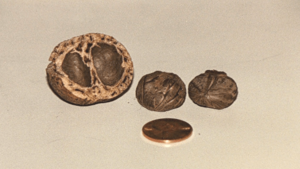Mongongo facts for kids
Quick facts for kids Mongongo nut |
|
|---|---|
 |
|
| Schinziophyton rautanenii | |
| Scientific classification | |
| Genus: |
Schinziophyton
|
| Species: |
rautanenii
|
| Synonyms | |
|
Ricinodendron rautanenii Schinz |
|
The mongongo tree is also known as the mongongo nut or manketti tree. Its scientific name is Schinziophyton rautanenii. This tree is part of the plant family called Euphorbiaceae. It is the only species in its monotypic genus Schinziophyton.
The mongongo is a large tree that spreads out wide. It can grow to be 15 to 20 meters (about 50 to 65 feet) tall. You can find it growing on wooded hills and among sand dunes. It especially likes the sandy soils of the Kalahari. The leaves of the mongongo tree look like a hand with fingers spread out. Its wood is light yellow and is similar to balsa wood. This means it is both light and strong. The tree also has yellowish flowers that grow in thin, loose bunches.
Contents
Mongongo Fruit
The fruits of the mongongo tree are called mongongo fruits, mongongo nuts, manketti nuts, or nongongo. These fruits are shaped like an egg and feel soft and velvety. They ripen and fall from the tree between March and May each year.
Each fruit has a thin outer skin. Inside this skin is a thick, hard, pitted shell. This shell protects an edible nut that is inside.
Where Mongongo Trees Grow
Mongongo trees grow widely across subtropical southern Africa. They are found in several different areas. The largest area stretches from northern Namibia into northern Botswana, southwestern Zambia, and western Zimbabwe.
Another area where they grow is in eastern Malawi. You can also find them in eastern Mozambique. Besides these places, mongongo trees also grow in Angola, Tanzania, and Zaire.
Traditional Uses of Mongongo Nuts

Mongongo nuts are a very important food for some groups of people. They are a main part of the diet for the San people who live in northern Botswana and Namibia. Old discoveries show that San communities have been eating these nuts for hundreds of years. People like mongongo nuts because they taste good. They are also popular because they can be stored for a long time and stay good to eat for most of the year.
To prepare the dry fruits, people first steam them. This makes the skins soft. After peeling, the fruits are cooked in water. The maroon-colored fruit part then separates from the hard inner nuts. People eat the soft fruit part. The nuts are saved to be roasted later.
Sometimes, nuts are collected from elephant dung. The hard nuts can pass through an elephant's digestive system without breaking. Once these nuts are dry, their outer shell cracks easily. This reveals the nut inside, which is covered by a soft inner shell. The nuts can be eaten whole or crushed and added to other dishes.
The oil from mongongo nuts has also been used for a long time. People rub it on their skin during the dry winter months. It helps to clean and moisturize the skin. The wood of the mongongo tree is both strong and light. This makes it great for making fishing floats, toys, and drawing boards. It can also be used as a material that keeps things warm or cool.
Mongongo Nut Nutrition
Mongongo nuts are very nutritious. Here is what 100 grams of shelled nuts contain:
- 24 grams of protein
- 57 grams of fat, which includes:
- 44% polyunsaturated fatty acids
- 18% monounsaturated fatty acids
- 17% saturated fatty acids
- 193 milligrams of calcium
- 527 milligrams of magnesium
- 4 milligrams of zinc
- 2.8 milligrams of copper
- 565 milligrams of vitamin E (a type of tocopherol)
Economic Importance
Richard Borshay Lee, a researcher, wrote about the mongongo nut's importance. He said that eating mongongo nuts is actually more reliable than growing food. This is because there are so many mongongo nuts available in nature.
He shared a story about a Bushman who was asked why he didn't start farming. The Bushman replied, "Why should we plant, when there are so many mongongo nuts in the world?" This shows how much the mongongo nut means to the people who rely on it.
See also
 In Spanish: Schinziophyton rautanenii para niños
In Spanish: Schinziophyton rautanenii para niños

